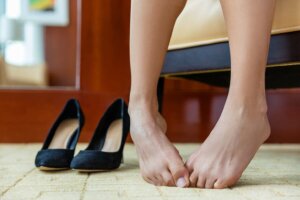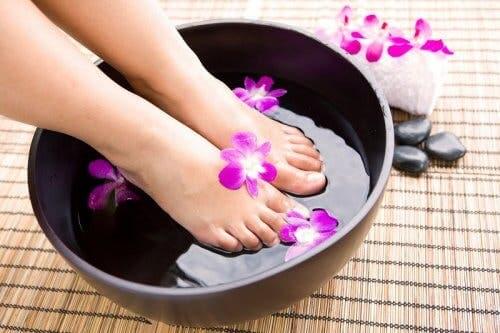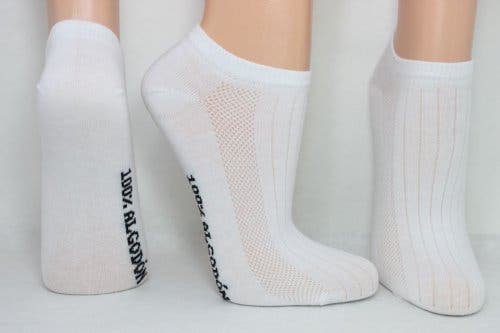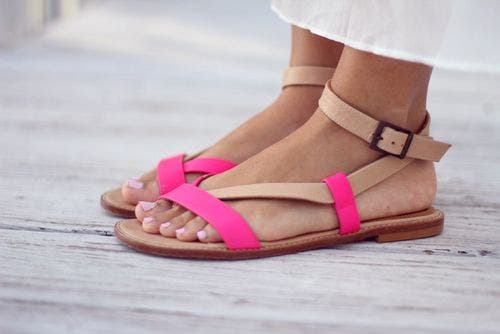How to Get Rid of Smelly Feet

Are you looking to get rid of smelly feet? If so, you’re definitely not alone.
Foot odor, a medical condition called bromhidrosis, is a very common problem that’s usually caused by the growth of bacteria on the skin of the feet. Although it’s often associated with poor hygiene, it has many causes.
There are currently many industrial products that promise to get rid of smelly feet, but it’s necessary to apply other care and habits to decrease or eliminate it.
In this article, we’ll share four important tips that you can apply every day.
Why you suffer from smelly feet
Before discovering the methods to get rid of smelly feet, it’s important to review its possible causes.
First, keep in mind that you have more sweat glands in your feet compared to other parts of your body. These glands release sweat all day to regulate your temperature and keep your skin moist. However, when your feet sweat excessively, you’re likely to suffer from smelly feet.
Sweat, added to the heat that’s enclosed in footwear, creates an environment conducive to the growth of bacteria, according to Dr. Das of Harvard University. Although these organisms naturally inhabit the feet and help break down the sweat, their proliferation can cause unpleasant aromas.
Read on to learn more: How to Get Rid of Germs and Dead Skin on Your Feet
Tips to get rid of smelly feet
Sometimes, the use of powders and deodorants isn’t enough to get rid of smelly feet. Although their formulas have improved noticeably in recent years, they sometimes only manage to temporarily neutralize it.
Therefore, it’s also important to apply other key tips.
1. Wash your feet every day to get rid of smelly feet

Correct foot hygiene is one of the most important aspects when it comes to fighting unpleasant odors. Because of this, it’s essential to do it every day, using a mild soap and a special foot brush.
The latter will facilitate the removal of dead cells and dirt.
What can I do?
- If you suffer from really smelly feet, wash them twice a day.
- You can do so during your morning shower or soak them in a basin with soap and water.
- After washing them, make sure to dry them very well, paying special attention to the skin between your toes, where traces of water usually remain.
2. Change your socks every day

It’s a matter of hygiene, of course. Changing your socks every day prevents the accumulation of moisture and bacteria that causes unpleasant odors. In fact, on hot days or when you do a lot of physical activity, it’s best to change them at least twice a day.
Now, although not all shoes look good with socks, it’s ideal to use them whenever possible. This garment prevents the skin of your feet from having direct contact with your shoes, preventing traces of sweat from remaining inside.
What can I do?
- Try to choose socks made of natural, breathable fibers. Avoid socks made of synthetic materials.
- When you can’t wear socks, use an antiperspirant for your feet.
- Be sure to wash your socks thoroughly before wearing them again.
Make sure you read: 5 Homemade Foot Odor Remedies
3. Alternate your shoes to get rid of smelly feet
To get rid of smelly feet, you should have at least two pairs of shoes.
Why?
Well, basically because this allows each pair of shoes to dry well from sweat or moisture before you use them again.
What can I do?
- Alternate your shoes at least every other day.
- While you aren’t using them, leave them in a cool and ventilated place so that the bad smell disappears.
- If you notice that they’re very moist, remove the insole and put them to dry in a warm place.
4. Wear open shoes

Ventilation of feet skin is key to getting rid of the bad smell moisture and the use of closed-toe shoes causes. Because of this, experts recommend using shoes that facilitate ventilation, such as sandals.
What can I do?
- Wear open shoes at least two hours a day so that your feet can air out.
- If possible, wear ventilated shoes whenever the weather is warm.
- Be sure to wear this type of footwear when you’re in public places, such as showers or swimming pools.
Talk to your doctor if the problem persists
If the problem persists and even worsens, you should go see your doctor. They may refer you to a dermatologist or endocrinologist, depending on your problem.
Perhaps an infection or even a hormonal imbalance is to blame for your smelly feet. In that case, you’ll need a specialized treatment that you can complement with the natural remedies we mentioned here.
Be that as it may, don’t let it affect your self-esteem. There are multiple treatments available and, if you make an effort, you can easily get rid of the problem.
All cited sources were thoroughly reviewed by our team to ensure their quality, reliability, currency, and validity. The bibliography of this article was considered reliable and of academic or scientific accuracy.
- Dreanno, C., Kirby, R. R., & Clare, A. S. (2006). Smelly feet are not always a bad thing: The relationship between cyprid footprint protein and the barnacle settlement pheromone. Biology Letters. https://doi.org/10.1098/rsbl.2006.0503
- Ara, K.; Hama, M.; Akiba, S.; Koike, K.; Okisaka, K.; Haqura, T.; Kamiya, T.; and F. Tomita. “Foot odor due to microbial metabolism and its control.” Canadian Journal of Microbiology. Vol. 52, no. 4. Pages 357-364. April 2006. (May 23, 2014) http://www.ncbi.nlm.nih.gov/pubmed/16699586
- Perera, E., & Sinclair, R. (2013). Hyperhidrosis and bromhidrosis: A guide to assessment and management. Australian Family Physician.
- Pandey, S. K., & Kim, K. H. (2011). Human body-odor components and their determination. TrAC – Trends in Analytical Chemistry. https://doi.org/10.1016/j.trac.2010.12.005
- Jesús Zalacain Vicuña, A., & titular Departamento Podología RESUMEN, P. (2010). INFECCIONES MICÓTICAS MÁS FRECUENTES EN EL PIE. Revista Española Podología.
- Mccann, M. (2014). Cuero, pieles y calzado. Enciclopedia de Salud y Seguridad En El Trabajo OIT.
- Das, Shinjita. Manuales MSD. https://www.msdmanuals.com/es-es/professional/trastornos-dermatológicos/trastornos-de-la-sudoración/bromhidrosis
This text is provided for informational purposes only and does not replace consultation with a professional. If in doubt, consult your specialist.








